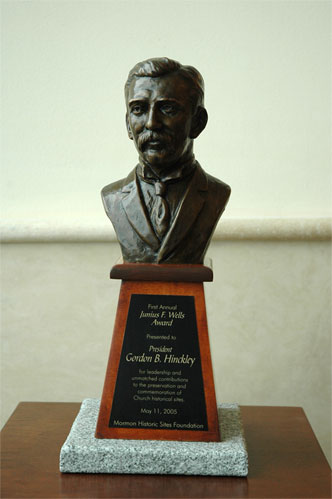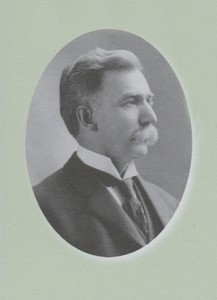Special Recognition: Wilford C. Wood
The Ensign Peak Foundation was pleased to honor and recognize the significant accomplishments and contribution of Wilford C. Wood, a leader and early pioneer in recognizing and acquiring significant Latter-day Saint historic sites. A banquet in his honor was co-hosted by the Ensign Peak Foundation and the LDS Church History Department.
Junius F. Wells Award
The Junius F. Wells award is presented from time to time by the Ensign Peak Foundation to an individual for outstanding achievement in preserving Latter-day Saint history. The award is named after Brother Wells whose efforts constituted the beginning of the Church’s endeavor to identify and appropriately designate sites in the East, which related to important events in the restoration of the gospel and the founding and development of the Church.
Family: Born June 1, 1854 to Daniel H. Wells and Hannah Free. Married Helena Middleton Forbes in June 1879; 2 children: Hugo H. Wells and Abbie H. Wells. Died April 15, 1935 in Salt Lake City, Utah.
Employment: Private business.
Education: Graduated from Deseret University.
Church Service: British Mission 1872-74; Mission to the Midwest and New England 1874-75; Called by Brigham Young June 1875 to organize the first Young Men’s Mutual Improvement Association; Served as first General Superintendant YMMIA 1876-80; Founding Editor Contributor Magazine 1879-92; British Mission 1919-21 where was Assistant EditorMillenial Star; Assistant Church Historian, 1921-35.
In 1905 Junius, by direction of President Joseph F. Smith, undertook a singular mission to purchase for the church 283 acres in Sharon Vermont, including the Solomon Mack farm, where Joseph Smith, Jr. was born December 23, 1805. He also conceived of a centennial commemoration at the Prophet’s birthplace, marked by a magnificent granite monument. With the approval of President Smith, and only a few months to execute the plan, Junius set to work. He designed the monument and selected the materials to be used. From a quarry in Barre Vermont, he selected the 46-foot-long stone from which was cut a 38 1/2 –foot shaft weighing 40 tons.
Junius then personally supervised its movement from the quarry to its final location atop Dairy Hill on the Mack farm. The transportation was beset with obstacles. A bridge had to be modified, and roads altered as 22 horses pulled their immense load toward the site. In mid-December, with time running out, they encountered a swampy spot at the base of Dairy Hill that made the road impassable. After every effort to get past it failed, Junius remarked, “I am going to pray about it.” The next morning when Junius arrived at the swamp hole, the temperature had dropped 30 or more degrees freezing it over. This allowed the horses to get across it without any difficulty.
Historian, T. Edgar Lyon, concluded that the purchase of the Mack farm and erection of the Monument “was the beginning of the Church’s effort to identify and appropriately designate sites in the East, which related to important events in the restoration of the gospel and the founding and development of the Church.” Later, Junius, oversaw the erection of the Monument to the Three Witnesses to the Book of Mormon at the grave of Oliver Cowdery in Richmond, Missouri, and the Hyrum Smith Memorial in the Salt Lake City Cemetery.
Speaking in tribute to Junius F. Wells, President Joseph F. Smith declared, “I don’t think there is another man in the Church who could have done it. I don’t know another man within the range of my acquaintance who could have accomplished the work that Junius F. Wells accomplished in building the monument in Vermont, in memory of the Prophet Joseph Smith. Events, quite as miraculous, I think if not more so, is the speed with which Brother Junius has accomplished this undertaking . . . in time for it to be dedicated on the hundredth anniversary of his birth.”

The award, a bust of Junius F. Wells, was crafted by well-known LDS sculptor Dee Jay Bawden. The bust rests on a stand made of wood from a sugar maple tree near the birthplace of the Prophet Joseph in Sharon, Vermont. The award also includes a granite base hewn from the same quarry in Barre, Vermont, from which the 38½ Joseph Smith, Jr. Monument was hewn and erected by Junius F. Wells in 1905.


